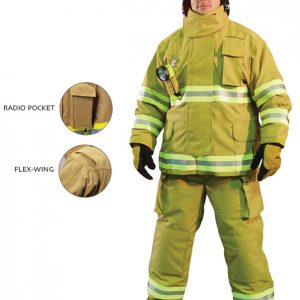Description
COMPLETE TURNOUT GEAR
, firefighters have not had access to the same level of protective clothing used today. Most fires were fought from the outside of buildings, and structures were rarely entered. Early in the history of firefighting, a firefighter’s outer clothing was more for warmth and dryness than for protection from fire. In the early 19th century, felt caps were worn of various designs and were more for decoration than service; this early headgear did not provide any protection against flame or head injury but did keep water off the firefighter’s face. The modern firefighter’s helmet was developed in 1830 by luggage maker Henry Gratacap, who was also a volunteer firefighter in New York City.[1] Gratacap recognized the need for a well-designed helmet that provided maximum protection to the wearer.[2] This helmet is immediately recognizable today as the “New York” style of helmet, and little has changed in terms of its shape. The helmet had a brimmed front to affix a face shield; it was usually adorned with a company name and number. The helmet featured eight rib sections on the dome for added rigidity and a long rear brim that channeled water away from the wearer’s neck.[3]
Firefighting trench coats, made of leather or canvas and later rubber, were the precursor to modern turnout jackets. Early coats had felt or wool liners to provide warmth in winter. These layers later developed into the thermal and flame protection liners found in today’s turnout gear. Earlier rubber coats were much longer than today’s modern turnout jackets, reaching down to a firefighter’s mid-thigh. They were worn with long rubber boots called “three-quarter boots” which reached above the firefighter’s knees. This interface of the boot and coat left a large gap of protection against fire. This system has since been replaced by the modern combination of a jacket, pants with suspenders, and shorter rubber or leather boots, although some departments still wear the old style of gear.
The combination of modern triple-layer turnout gear with self-contained breathing apparatus (SCBA), personal alert safety system (PASS) device, and modern communications equipment is intended to provide comprehensive protection against smoke, heat, water, steam, flashovers, and even direct flame for a short time.[4] Modern turnout jackets and pants are made of fire-retardant fabrics, mainly aramids such as Nomex and Kevlar or polybenzimidazole (PBI). The National Fire Protection Association publishes the requirements for fire protective clothing under NFPA 1971: Standard on Protective Ensembles for Structural Fire Fighting and Proximity Fire Fighting, which specifies “the minimum design
urnout clothing can consist of a combination of trousers, suspenders, boots, and a jacket. Modern sets use a trouser/jacket combination. The advantage of this combination is overlapping coverage to create a protective envelope for the firefighter to operate in.
It has been noted[by whom?] that young children in dangerous circumstances like a building fire may be further frightened by the appearance of firefighters equipped in full turnout gear. Many fire departments have school presentations intended to familiarize children with firefighters and their appearance so as to ensure they will be calm and cooperative during emergencies.[citation needed]
Materials
According to NFPA 1971: Standard on Protective Ensembles for Structural Fire Fighting and Proximity Fire Fighting (and most equivalent standards in other countries), all turnout clothing must have three components: an outer shell, a moisture barrier, and a thermal barrier. Separating these layers are pockets of air referred to as “dead zones”. These layers of air, along with the three layers, help to further insulate the wearer from the extreme environments of fires. Turnout pants are typically outfitted with knee pads and leather cuffs.
The materials used for the layers in turnout trousers and coats vary but often include a Nomex or Kevlar composite. For example, the materials used by the Los Angeles City Fire Department, as found in their 2005 recruit handout are as follows:
- Outer shell: Southern Mills, Advanced, Nomex/Kevlar blend in a “rip-stop weave”, with water repellent finish.
- Thermal insulated layer: Southern Mills Caldura batten quilt material.
- Thermal and moisture barriers are sewn together for removal for cleaning, repair, and replacement from the outer shell.
- Moisture barrier: Breathe-Tex material combined with Nomex/Kevlar blend laminated cloth.
NFPA 1500: Standard on Fire Department Occupational Safety, Health, and Wellness Program and similar standards mandate that firefighters wear upright protective collars and sleeves.





Reviews
There are no reviews yet.